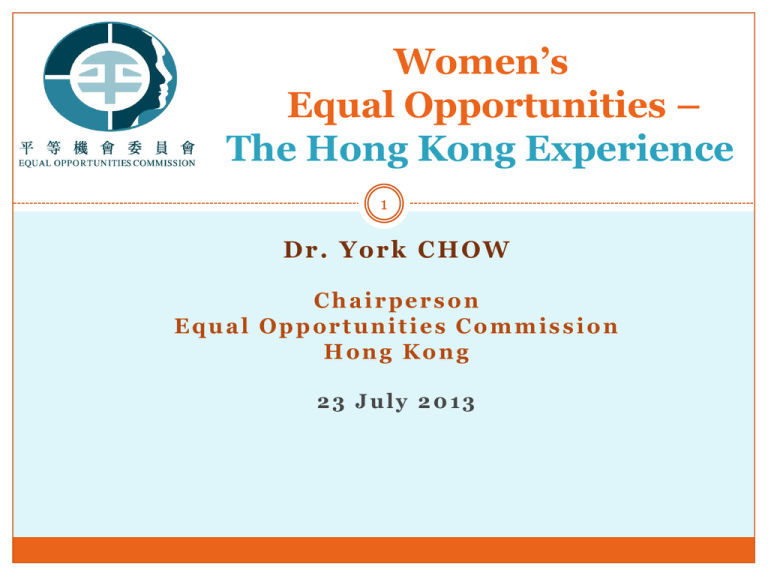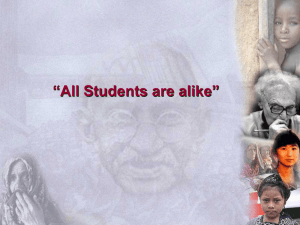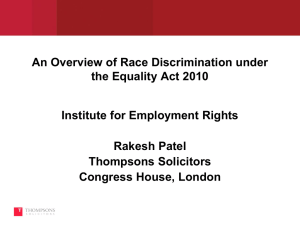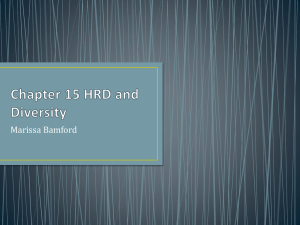
Women’s
Equal Opportunities –
The Hong Kong Experience
1
Dr. York CHOW
Chairperson
Equal Opportunities Commission
Hong Kong
23 July 2013
Historical Review (I)
2
Before 1960s:
women were mostly family carers.
1960s:
Creation of a vast amount of blue-collar and white-collar job opportunities;
Higher education level, simpler family structure, and better employment opportunities
and economic prospects also encouraged more women to participate in economic
activities.
1970s:
The Government started to provide 6-year free basic education to local boys and girls
in 1971 and the free education was extended to a period of 9 years in 1978.;
In 1975, female civil servants began to enjoy equal pay as their male counterparts.
Historical Review (II)
3
1980s and 1990s:
Legislation was passed for paid maternity leave; the enactment of the former
Domestic Violence Ordinance; the passage of the Inland Revenue (Amendment)
Ordinance, which provided for separate taxation for married women; the right for
female indigenous villagers to inherit land in the New Territories in the absence of
a will; the enactment of the Sex Discrimination Ordinance and the establishment
of the Equal Opportunities Commission.
Extension of the Convention on the Elimination of All
Forms of Discrimination against Women (CEDAW) to
Hong Kong.
21st Century:
Since the 1980s, local women’s groups
have been advocating the establishment of
a central mechanism on women’s affairs.
The Government set up Women’s
Commission on 15 January 2001.
Legal Protection against
Sex Discrimination
4
The Basic Law
The Hong Kong Bill of Rights Ordinance
International Covenant on Civil and Political Rights
(ICCPR)
International Covenant on Economic, Social and
Cultural Rights (ICESCR)
Convention on the Elimination of All Forms of
Discrimination Against Women (CEDAW)
Sex Discrimination Ordinance (SDO)
Family Status Discrimination Ordinance (FSDO)
Birth of the Sex Discrimination Ordinance
5
Sexual Discrimination Ordinance – a private initiative
Ms Anna Wu, the then legislative councillor ,
introduced the Equal Opportunities Bill (EOB) in the
form of a Private Member’s Bill in the Legislative
Council of Hong Kong in 1994.
Outlawing discrimination on various grounds
including sex, disability, family responsibility,
sexuality, age, race, religious, etc.
Under pressure, the Government agreed to introduce legislation
against sex and disability discrimination (the Sex Discrimination Bill
and Disability Discrimination Bill).
The Sex Discrimination Ordinance was passed in 1995.
The Sex Discrimination Ordinance (SDO)
6
Outlaw discrimination on the basis of sex, marital status and
pregnancy, and sexual harassment;
Examples:
Cannot dismiss or transfer a pregnant woman into a lower paying position;
Unlawful for an employer to discriminate against a job applicant on the
basis of sex unless if a person's sex is a genuine occupational qualification
for the job.
Applies to both males and females;
Code of Practice on employment under the SDO;
Provides for the establishment of the Equal Opportunities
Commission (EOC).
Protection in Seven Fields under the SDO
7
Employment
Activities of
Government
Participation
in clubs
Education
Protection
in Seven
Fields
Eligibility to
vote for and to
be elected or
appointed to
advisory
bodies
Provision of
goods/
facilities /
services
Disposal or
management
of premises
Enquiries & Complaints related to
Sex Discrimination
8
Sex Discrimination Ordinance Related Enquiries & Complaints
2010
2011
2012
2013
(Jan-June)
No. of SDO related enquiries
822
878
1045
604
No. of SDO related
complaints
303
262
282
110
No. of pregnancy
discrimination complaints
150
130
97
43
No. of sexual harassment
complaints
83
64
115
43
An average of 87% of the complaints related to sex discrimination are made
lodged by women for the past three and a half years.
An average of 94% of sexual harassment complaints are raised by women from
January 2010 to June 2013.
Family Status Discrimination
Ordinance
9
Passed in 1997.
Unlawful for anyone or any organisation to discriminate
against a person, male or female, on the basis of family
status.
Applies to the same seven areas as what the SDO covers .
Example:
An employer CANNOT turn down an employee’s promotion or
transfer him/her because of his/her family status, e.g. after knowing
that the employee is the only carer of his/her young son at home .
The Equal Opportunities Commission
10
A statutory body established under the SDO on 20 May
1996.
Commenced operation on 20 September 1996.
Independent of the Government .
S63(7) of the SDO: the EOC “shall not be regarded as a
servant, or agent of the Government” .
Accountable to the public .
Governed by a Board comprising of a full-time
Chairperson and 16 members from different
backgrounds .
Main Objectives of the EOC
11
To implement the SDO, the Disability Discrimination Ordinance, the
Family Status Discrimination Ordinance (FSDO), and the Race
Discrimination Ordinance.
To work towards the elimination of discrimination on the grounds of sex,
marital status, pregnancy, disability, family status and race.
To eliminate sexual harassment, and harassment and vilification on the
grounds of disability and race.
To promote equality of opportunities between men and women, between
persons with and without a disability and irrespective of family status and
race.
What the EOC does (I)
12
Investigate complaints &
encourage conciliation
between parties in dispute
• In 2011/2012, 16,800 enquiries answered
and over 1,000 complaints handled;
• 64% successful conciliation rate.
Provide legal assistance
• About HK$2,800,000 was secured in
compensation for complaints through
conciliation & legal assistance in 2011/12.
Promote antidiscrimination and equal
opportunity values and
policies
• More than 47,000 employers, employees
and interested parties received our
training in 2011/12;
• More than HK$1,570,000 were granted
to fund 63 community projects to
promote equal opportunities in 2011/12.
What the EOC does (II)
13
Public Education
• In 2011/12, 71,000 students watched our EO
plays;
• More than 4,500 university students used the
online training module developed by the EOC
since its launch in 2007.
Review
legislation and
provide
guidelines
• Revised Code of Practice on Employment under the
DDO in 2011/12;
• Conducting a comprehensive review of the 4
discrimination ordinances.
Conduct
researches
• In 2013, research reports released include the
Sexual Harassment - Questionnaire Survey for
Education Sectorthe, the Study on Students'
Sexual Attitudes and Views on Sexual
Harassment, the Equal Opportunities Awareness
Survey 2012, etc.
What the EOC has done to achieve
Women’s Equal Opportunities
14
Elimination of Discriminatory Advertisements;
Remove the gender-based discriminatory elements
in the Secondary School Places Allocation (SSPA)
System;
Eliminate Gender Stereotyping in Textbooks;
Cracking the Dress Code
Combating Pregnancy Discrimination; and
Eliminate Sexual Harassment.
Discriminatory Advertisements
15
Unlawful to publish discriminatory Advertisements under the discrimination
ordinances in HK, including the SDO and the FSDO.
(i) Education and publicity:
The EOC regularly monitor recruitment advertisements and work closely with
publishers, advertisers and employment agencies;
(ii) Legal proceedings
The EOC has power under the discrimination ordinances to bring legal
proceedings against publishers and advertisers.
In the year 1997/98, the EOC has taken court action on 18 advertisements
appearing in 5 newspapers and fines were imposed.
(iii) Significant drop in discriminatory advertisements:
December 1996 -- 37% advertisements in print media were discriminatory;
March 1998 – Less than 1%.
Fostering Fairer Access to Education
16
Secondary School Places Allocation (SSPA) System
A System used by the Education Department to allocate places for Primary 6
students into Secondary Schools since 1978.
Formal Investigation
The EOC received complaints. Formal investigation by the EOC into SSPA
System started in September;
The SSPA System was discriminatory on the basis of sex in 3 areas:
a.
the scaling of internal assessment scores using separate gender curves;
b.
the banding of students by sex; and
c.
the sex quotas for placement in co-educational secondary schools.
The SSPA system led to systematic scaling down of the best girls’ scores and
scaling up the best boys’ scores which restricted girls’ access to the best schools.
The EOC recommended: the Government should develop an allocation system
without any discriminatory elements to ensure that boys and girls are placed into
secondary schools fairly.
Fostering Fairer Access to Education
17
Judicial Review of the SSPA System
August 1999 – The EOC investigation report found that the SSPA system
discriminatory;
April 2000 – The Education Department (ED) said that there were good
reasons to keep the SSPA System as it was;
July 2000 – The EOC applied to the court for judicial review of the SSPA
System;
June 2001 -- The High Court ruled that all three gender-based
mechanisms in the SSPA System challenged by the EOC are
discriminatory and unlawful under the SDO;
July 2001 – The ED introduced relief measures to place affected students;
2002 – The ED removed the 3 gender-based features of the SSPA System
with effect from the 2002 allocation.
Gender Stereotyping in Textbooks
18
Content analysis on textbooks and teaching materials in respect of
stereotyping was conducted in late 1999;
Examined nearly 70,000 references to human characters and
interviewed students, teachers and publishers;
Analysis showed:
Female characters occurred less often than male;
Reinforced traditional family roles with the father working and
contributing to society with achievers tending to be male, while
mothers stayed at home; and
There was only one mention of single parenthood.
The study also prepared a set of guidelines for the development of
education materials;and
Teacher and publishers agreed that guidelines would be a useful
reference in avoiding stereotypes in educational materials.
Cracking the Dress Code
19
2010
The EOC granted legal assistance to a complainant
who alleged that she was discriminated against by
the school on the ground of her sex by imposing on
her a dress code under which all female teachers were
required to wear a dress or a skirt to work, and
eventually she was pressurized to resign;
The case raises a question of sex discrimination in the
field of employment; and
After a writ was issued by the EOC, the school
agreed to settle the matter giving an apology and
monetary payment to the complainant. The school
also undertook to review its dress code.
Eliminate Pregnancy Discrimination
20
1.
Resignation under pressure is a dismissal:
February 2001 – the Court ruled that the employer
discriminated against the plaintiff because of her
pregnancy, and that she was victimized after she
had lodged a complaint with the EOC.
The ruling made it clear that a resignation under
pressure would be treated as constructive dismissal.
2.
Set precedent by awarding damages in a
pregnancy discrimination case:
May 2003 – The Court held that an elderly home
unlawfully discriminated against a pregnant woman
by refusing to employ her as a supervisor.
The Court awarded damages of 3 different
components: Loss of income; Injury to feelings; and
Punitive damages.
Eliminate Sexual Harassment
21
Court case:
In 2010, an employer was held by the Court that it was vicariously liable for
employee’s act of sexual harassment as it did not take reasonable practicable
steps to prevent sexual harassment in the workplace.
Damages of HK$80,000 was awarded to the complainant.
Surveys in 2011 and 2013:
An EOC survey on the Students’ Sexual Attitudes and Views on Sexual
Harassment found that 50% of the responded students experienced various
forms of sexual harassment during the past one year.
An EOC questionnaire survey found that 47% of the 321 respondents said
that their schools have not yet adopted any sexual harassment policy.
Seminars:
The EOC held 4 seminars in early July to promote the formulation of a
comprehensive and effective sexual harassment policy in schools; more than
800 school principals, vice-principals and senior teachers attended.
Women in the Labour Force
22
Labour Force and Labour Force Participation Rates
of Hong Kong (LFPRs) by Sex
Male
Female
Period
Number (’000) LFPR (%)
Number (’000) LFPR (%)
1982
1 600.3
81.3
897.8
47.5
1987
1 727.5
80.3
1000.7
48.7
1992
1 766.0
78.1
1026.3
46.3
1997
1 954.9
75.1
1279.9
47.9
2002
1 958.1
72.4
1514.5
51.9
2007
1 953.6
70.4
1668.7
53.1
2012
1 972.1
68.7
1813.1
53.6
Source: Census and Statistics Department
Educational Attainment
23
Number of Female Students in University Grants Committee-Funded
Programmes (Excluding Sub-degree programmes)
Sex
1986/87
1991/92
1996/97
2001/02
2006/07
2010/11
Female
6,660
15,833
28,939
32,612
32,917
35,516
(37.2%)
(41.2%)
(46.2%)
(51.5%)
(52.3%)
(52.5%)
Source: Women’s Commission
Women’s Population in Hong Kong (Foreign Domestic Helper Excluded)
1996
2001
2006
2011
Population
3,067,000
3,209,600
3,362,900
3,480,700
Proportion
48.8%
49.5%
50.7%
51.3%
Source: Census and Statistics Department
Women Professionals
24
1. Certified Public Accountants
Thousands (%)
Source: Hong Kong Institute of Certified Public Accountants
Women Professionals (II)
25
2. Solicitors Holding Practising Certificates
Thousands (%)
Source: The Law Society of Hong Kong
Women Professionals (III)
26
3. Fully Qualified Engineers
Thousands (%)
Source: The Hong Kong Institution of Engineers
Women in Poverty
27
Poverty Rate by Sex in Hong Kong (2001 – 2011)
Source: The Hong Kong
Council of Social Service
Employment Earnings (2010)
28
Educational
Attainment
Median (HK$)
Female
Male
No schooling /
Pre-primary
5,500
7,500
Primary
6,000
9,000
Lower secondary
6,800
9,500
Upper secondary
/ Sixth-form
10,000
11,500
Post-secondary:
non-degree
12,000
14,000
Post-secondary:
degree
20,000
28,000
Overall
10,000
12,000
Source: Women’s Commission
Women on Board
29
Aggregate percentage of
women on boards in 2011
Global
10.5%
Hong Kong
9.4%
China
8.5%
Japan
1.1%
South Korea
1.9%
India
5.2%
Taiwan
5.8%
Singapore
7.0%
UK
10.7%
USA
12.6%
Norway
36.3%
Source: GMI Rating’s 2012 Women on Boards Survey
Social and Political Participation
30
1. Female Members in Legislature/Lower House of Parliament
Proportion
Legislative
Council of
Hong Kong
(2012-2016)
World
Eastern Asia
Western
Europe
16%
17%
14%
29%
Source: Legislative Council of Hong Kong and Department of Economic and Social Affairs, United Nations
2. Female Directorate Officers in the Civil Service
Source: Census and Statistics Department
My Dream
31
“You may say I’m a dreamer
But I’m not the only one
I hope someday you’ll join us
And the world will be as One”
~ IMAGINE by John Lennon









